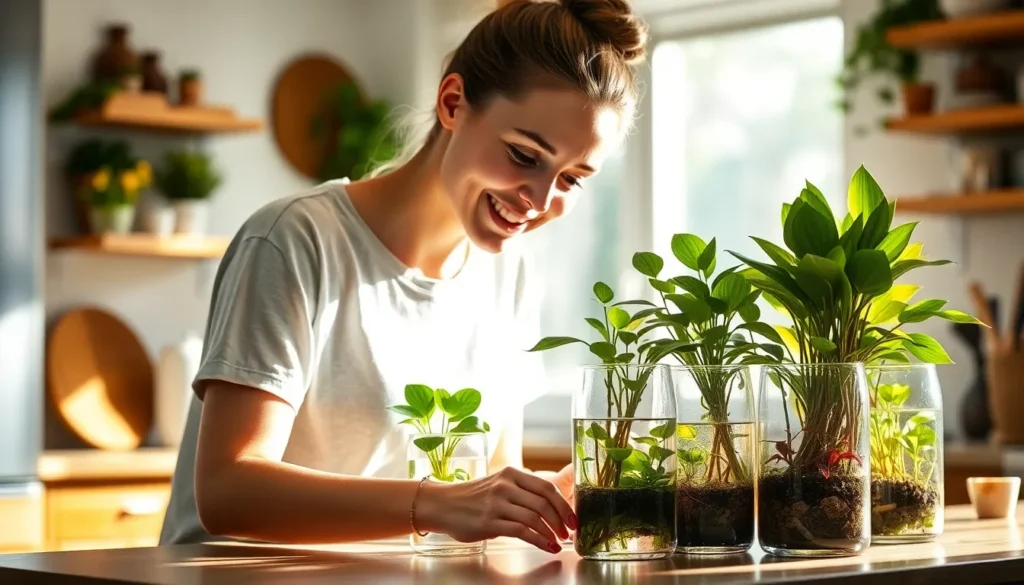We’ve all been there – staring at a bare corner in our home and wondering how to bring it to life with something fresh and vibrant. Indoor water plants offer the perfect solution, combining natural beauty with surprisingly low maintenance. These aquatic beauties don’t just purify our air; they create stunning focal points that transform any space into a serene oasis.
What makes indoor water plants even more appealing is how simple they are to set up ourselves. We don’t need expensive equipment or complicated systems to get started. With just a few basic supplies and the right plant selections we can create our own thriving water garden right on our windowsill or desk.
Whether we’re complete beginners or seasoned plant parents looking for something new these DIY water plant projects will revolutionize how we think about indoor gardening. Let’s jump into the industry of aquatic plants and discover how easy it is to bring this calming element into our homes.
Choose the Right Plants for Your Indoor Water Garden
Selecting the perfect water plants for your DIY indoor garden sets the foundation for a thriving aquatic network. We’ll explore plant varieties that adapt beautifully to indoor conditions while requiring minimal care.
Low-Maintenance Aquatic Plants for Beginners
Pothos tops our list of beginner-friendly water plants that flourish in simple glass containers. These trailing vines develop robust root systems within days and tolerate various lighting conditions. We recommend starting with golden pothos or marble queen varieties for their striking foliage patterns.
Lucky bamboo creates elegant vertical displays in tall vases filled with clean water. This resilient plant requires only weekly water changes and thrives in indirect sunlight. We’ve found that grouping three to five stalks together creates more visual impact than single stem arrangements.
Spider plants produce cascading plantlets that root effortlessly in water-filled propagation stations. These hardy specimens multiply quickly and create natural air-cleaning networks throughout your home. We suggest using clear containers to showcase their developing white root systems.
Philodendrons adapt seamlessly from soil to water cultivation with their heart-shaped leaves and climbing tendencies. These tropical beauties establish water roots within two weeks and continue growing indefinitely. We prefer heartleaf philodendrons for their compact size and rapid propagation abilities.
Tropical Water Plants That Thrive Indoors
Water hyacinth brings exotic purple blooms to indoor water gardens when provided with bright, indirect light. These floating plants create natural focal points in wide containers or decorative bowls. We recommend maintaining water temperatures between 65-75°F for optimal flowering cycles.
Water lettuce forms rosettes of soft, velvety leaves that multiply through runner production. This tropical specimen filters water naturally while creating lush green carpets across container surfaces. We’ve observed best growth rates in containers with at least 6 inches of water depth.
Arrowhead plants transition beautifully from soil to hydroponic systems with their distinctive arrow-shaped foliage. These adaptable tropicals develop extensive root networks in water and tolerate lower light conditions. We suggest rotating containers weekly to promote even growth patterns.
Monstera deliciosa cuttings create dramatic indoor water displays with their iconic split leaves and aerial roots. These statement plants establish quickly in large glass vessels and continue developing new fenestrations. We recommend choosing cuttings with at least two nodes for successful water propagation.
Air-Purifying Water Plants for Better Indoor Quality
Peace lilies excel at removing formaldehyde, benzene, and trichloroethylene from indoor air while thriving in water culture. These elegant bloomers produce white spathes when provided with consistent moisture and filtered light. We’ve measured important air quality improvements in rooms containing multiple peace lily specimens.
Snake plants filter toxins like xylene and toluene through their thick, upright leaves when grown hydroponically. These architectural specimens store water in their fleshy foliage and require minimal maintenance schedules. We recommend placing them in bedrooms where their nighttime oxygen production enhances sleep quality.
Chinese evergreens combine striking variegated patterns with powerful air-cleaning capabilities in water-based growing systems. These colorful specimens remove ammonia and other household pollutants while adapting to various indoor lighting conditions. We prefer red or pink varieties for their vibrant coloration in water gardens.
Rubber trees process airborne chemicals through their glossy, broad leaves when established in hydroponic containers. These tropical specimens develop substantial root systems in water and grow into impressive indoor trees. We’ve found that pruning encourages bushier growth patterns in water cultivation setups.
Select the Perfect Containers for Your DIY Water Plant Setup
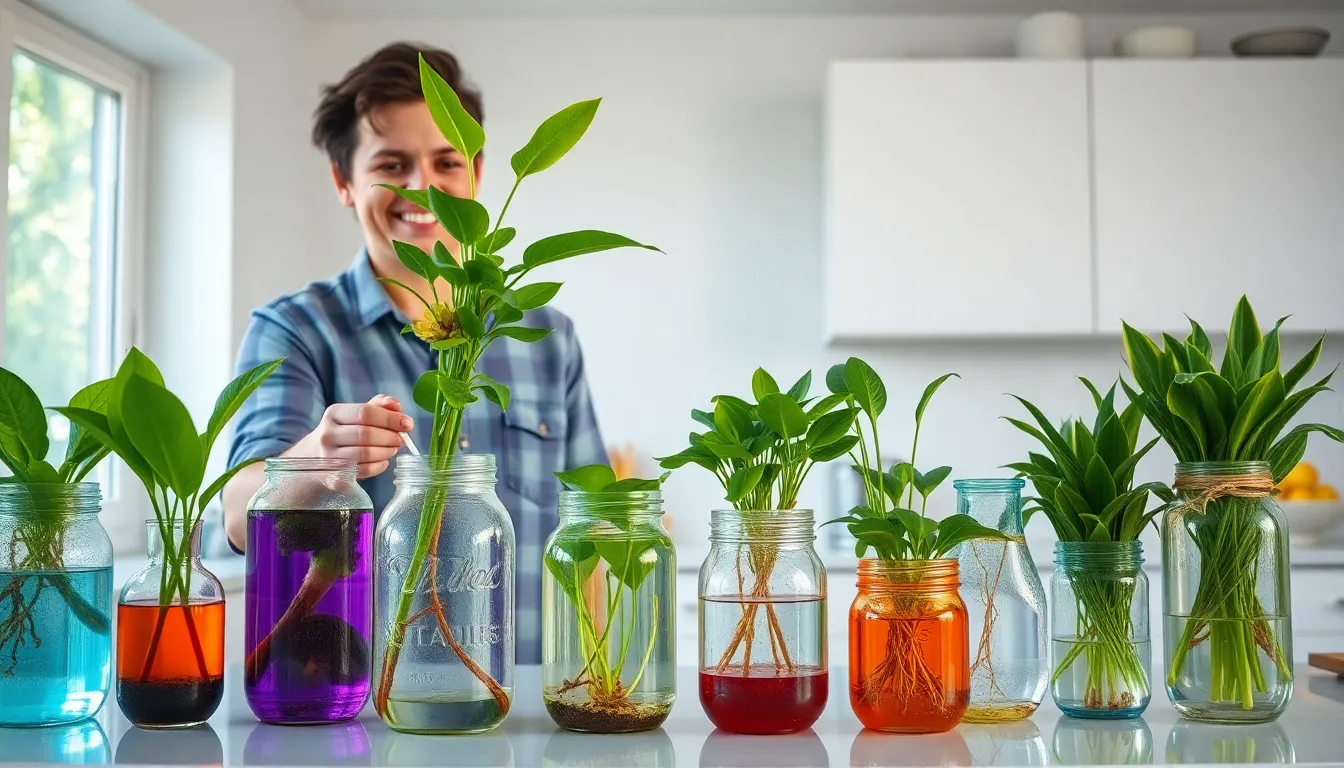
Now that we’ve chosen our plants, we need containers that’ll support healthy growth while improving our home’s aesthetic appeal. The right vessel makes all the difference between a thriving water garden and a disappointing experiment.
Glass Vases and Jars for Modern Aesthetics
Glass vases provide the most elegant solution for displaying our indoor water plants. Clear vessels showcase both the graceful roots and water levels, creating stunning visual displays that serve as living art pieces. We can choose from various shapes and sizes, with narrow-necked options being ideal for supporting one or two stems while keeping plants perfectly upright.
Mason jars from our pantries work exceptionally well as permanent homes for rooting cuttings. These common kitchen containers offer the perfect balance of functionality and rustic charm for our water plant setups. Regular drinking glasses create equally effective displays, while trendy test tubes add a modern scientific aesthetic that’s perfect for propagating single stems.
Wall-mounted vessels elevate our displays without requiring direct sunlight placement. Wood-mounted test tubes or hanging glass globes transform any wall into a living gallery, maximizing our growing space while creating eye-catching focal points throughout our homes.
Repurposed Household Items as Creative Planters
Plastic bottles become innovative self-watering systems when we drill holes in their caps and invert them into soil. This drip irrigation method provides consistent moisture release, making it perfect for maintaining our water plants when we’re away from home.
Cotton rope or nylon cord creates effective wicking systems by connecting water containers to our soil-based pots. These simple materials ensure consistent moisture levels while reducing our daily maintenance requirements. We can thread these wicks through drainage holes, allowing plants to draw water as needed.
Old containers like yogurt cups, takeout containers, or even tin cans transform into functional planters with minimal effort. These repurposed items add character to our displays while reducing household waste, making our water gardens both eco-friendly and budget-conscious.
Sizing Guidelines for Different Plant Types
Starting small ensures our newly clipped stems don’t struggle in oversized containers. Small bottles or shallow bowls provide the perfect environment for initial root development without risking water stagnation that could harm delicate new growth.
Growth progression requires container upgrades as our plants mature. We should move established plants to larger vessels that accommodate expanding root systems while providing adequate water volume for sustained growth. This gradual sizing approach prevents shock while supporting healthy development.
Container proportions must match each plant’s exact needs to maintain optimal growing conditions. Oversized vessels can cause water stagnation and root rot, while containers that are too small restrict growth and require constant refilling. Multiple plant displays need containers with sufficient water capacity to support our chosen wicking or drip systems effectively.
Prepare Your Water and Growing Medium
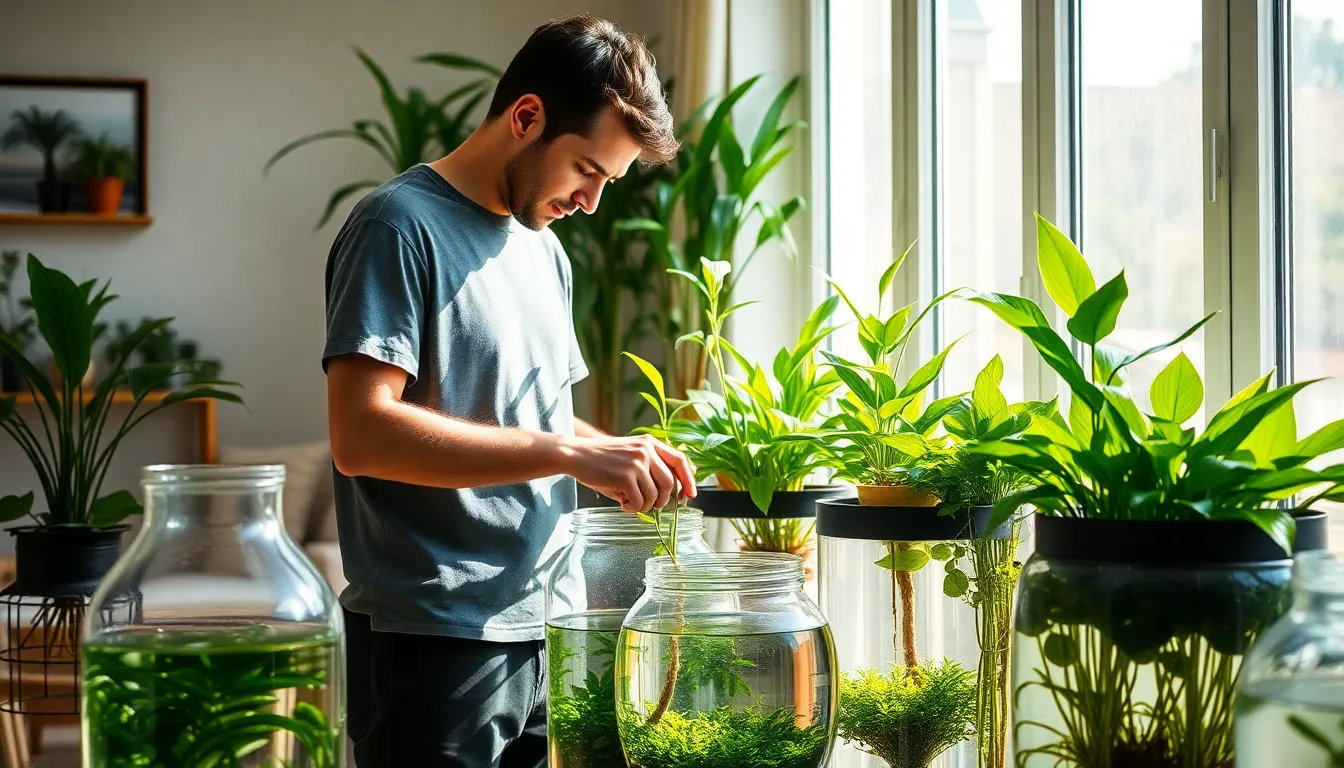
Getting our water and growing medium ready sets the foundation for thriving indoor water plants. We’ll explore essential water quality standards and enhancement options that ensure optimal plant health.
Water Quality Requirements for Healthy Growth
Clear, clean water forms the cornerstone of successful indoor water gardening. We recommend using bottled water, rainwater, or tap water that’s been left to stand for 24 hours to allow chlorine to dissipate naturally. Chlorine can harm delicate plant roots and inhibit healthy growth patterns.
Replace the water every few weeks or whenever it becomes cloudy to maintain optimal conditions. Fresh water prevents bacterial buildup and ensures our plants receive clean nutrients. We should monitor water clarity regularly and top off evaporation with fresh water to maintain consistent levels.
Positioning matters just as much as water quality for our indoor garden success. We need to place containers in bright, indirect light while avoiding heat sources like radiators or fireplaces. This creates an ideal environment that promotes steady growth without temperature stress.
Natural Additives to Boost Plant Health
Liquid organic houseplant fertilizer provides essential nutrients that plain water lacks. We can add a few drops periodically to encourage root development and overall plant vigor. This supplementation dissolves easily in water and delivers nutrients directly to the root system.
Moderation is key when adding fertilizers to prevent water contamination or root damage. We should use organic options sparingly since over-fertilizing can create imbalances that harm our water plants. A light feeding schedule every few weeks typically provides sufficient nutrition.
Monitoring our plants’ response to additives helps us adjust feeding schedules accordingly. We’ll notice improved leaf color and stronger root systems when nutrients are properly balanced. Signs of over-fertilization include algae growth or yellowing leaves.
Alternative Growing Mediums Beyond Plain Water
Self-watering systems using wicking ropes offer a hybrid approach that combines soil stability with constant moisture. We can create these DIY systems using simple materials like cotton rope and containers. The wicking action draws water from a reservoir to keep soil consistently moist.
These automated watering systems work well for gardeners who prefer soil but want consistent hydration. We simply thread the rope through drainage holes and into a water reservoir below. This method reduces maintenance while providing the benefits of both soil and water growing.
Crafting our own wicking systems allows customization for different container sizes and plant needs. We can adjust rope thickness and reservoir capacity based on our exact setup requirements. This flexibility makes the system adaptable to various indoor spaces and plant types.
Master the Art of Propagation for Water Plants
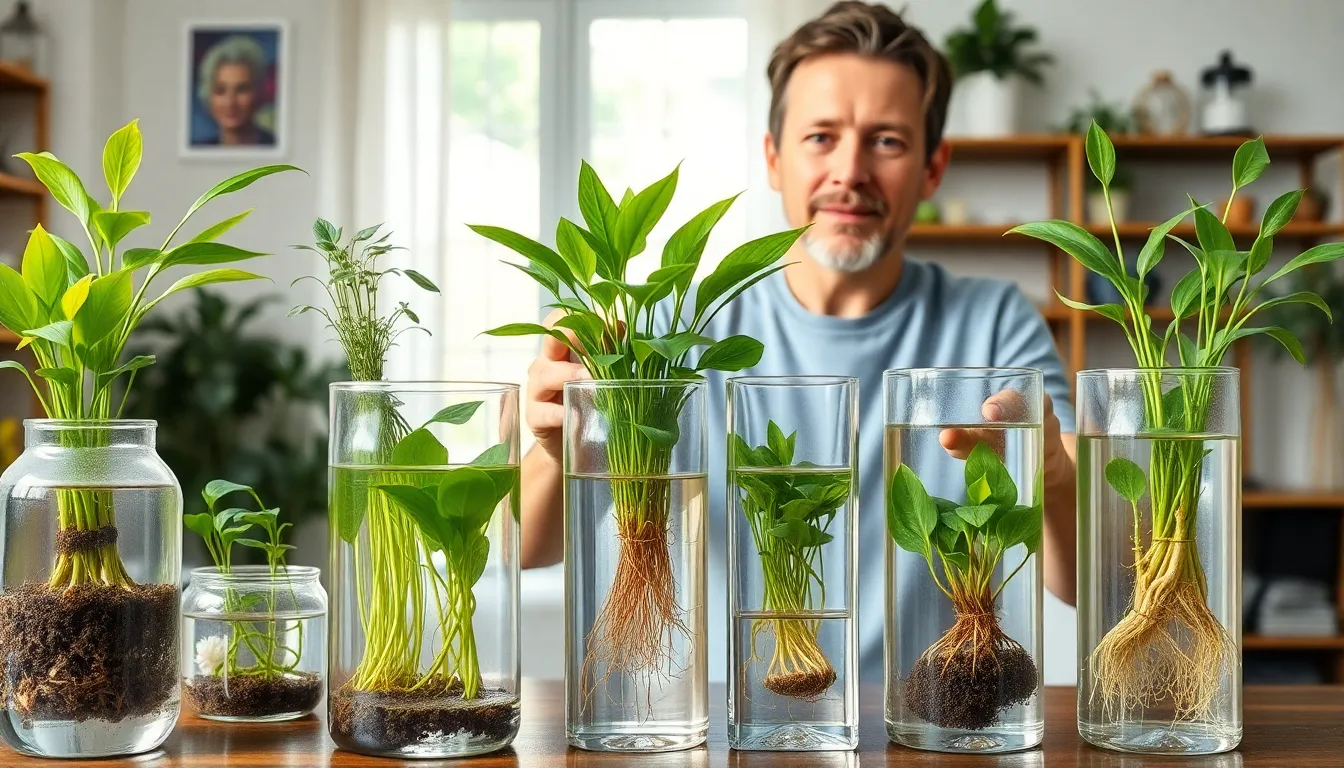
Now that we’ve set up our containers and prepared the perfect growing environment, we can multiply our indoor water plants through simple propagation techniques. Water propagation allows us to visually monitor root development while often achieving faster results compared to traditional soil methods.
Cutting Techniques for Stem Propagation
Identify nodes along the stem where leaves and roots naturally develop. Popular houseplants like Pothos, Philodendron, Monstera, Syngonium, and Hoyas root easily when we cut just below these critical growth points.
Make clean cuts using sterilized scissors to take stem cuttings with at least 2-3 nodes. Remove lower leaves so nodes can stay submerged without causing foliage to rot in the water.
Place cuttings in clean glass containers filled with room temperature water covering the nodes completely. We change the water every 3-5 days to maintain freshness and prevent bacterial buildup.
Monitor root development closely as new roots typically appear within days to a few weeks. Once roots reach a few inches long, we can either pot them in soil or continue growing them in water permanently.
Encourage new growth on mother plants by removing cuttings, which breaks apical dominance and stimulates fresh side shoots to emerge.
Root Division Methods for Established Plants
Remove mature plants from their containers when they’ve developed multiple clumping sections with established root systems. Snake plants, ferns, and certain aroids respond particularly well to this multiplication method.
Gently separate root clusters by teasing apart sections that contain their own stems and healthy root networks. We avoid forcing divisions and instead work with natural separation points.
Pot each division separately in fresh water or appropriate growing medium to allow independent growth. This technique works especially well for plants that naturally form offsets or runners.
Ensure adequate root coverage for each new division before separating to guarantee successful establishment in their new containers.
Seed Starting in Water for Exact Varieties
Select aquatic or semi-aquatic varieties that naturally germinate in moist conditions. Water lettuce and certain Alocasias can be successfully started from seeds using water-based methods.
Soak seeds on wet substrate while maintaining consistently humid conditions throughout the germination period. We monitor moisture levels carefully to prevent seeds from drying out or becoming waterlogged.
Control environmental conditions by keeping seed containers in warm locations with indirect light. Patience becomes essential as water seed starting typically takes longer than cutting propagation.
Maintain sterile growing conditions by using clean water and containers to prevent fungal issues that commonly affect seeds in high-moisture environments.
Create Optimal Growing Conditions Indoors
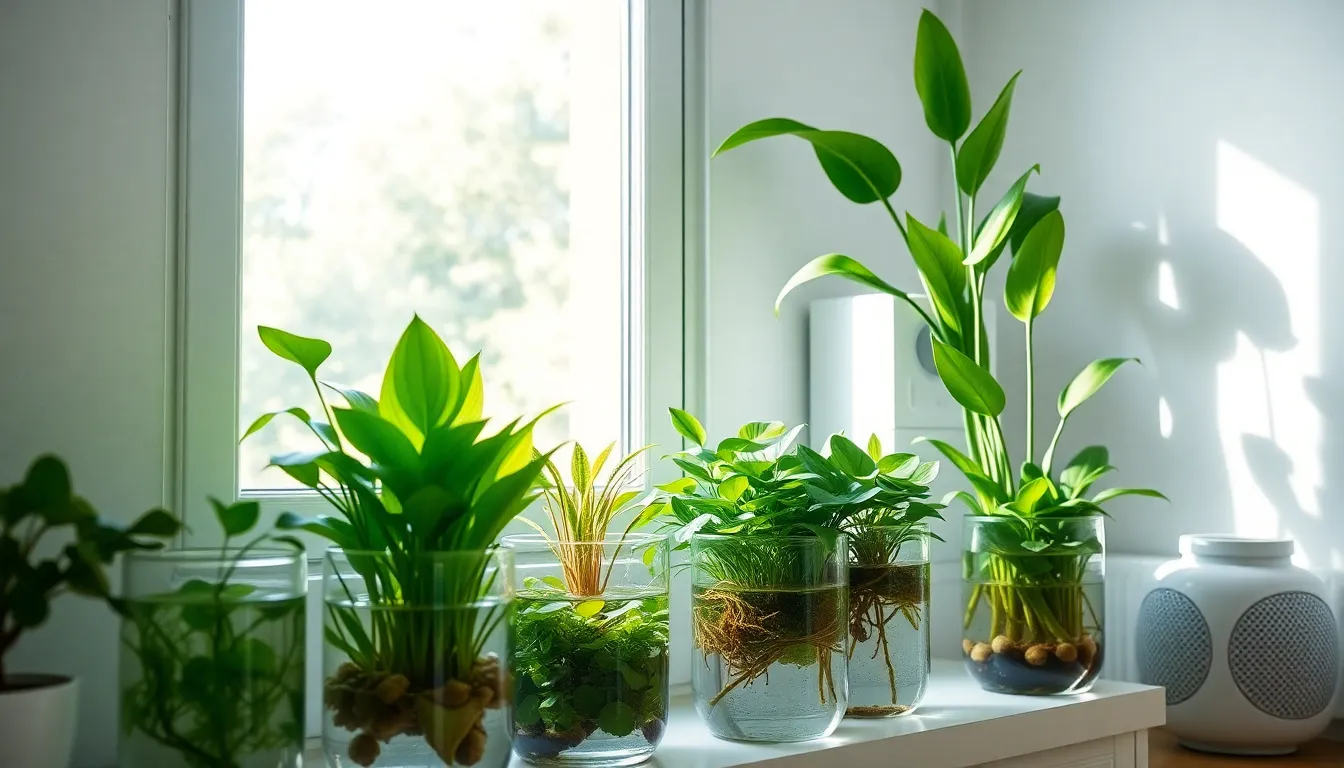
We’ll transform your water plant setup into a thriving indoor network by mastering the environmental factors that promote healthy growth. Proper conditions ensure our water plants develop strong root systems and vibrant foliage.
Lighting Requirements for Different Water Plants
Bright indirect light serves most indoor water plants best, with 4-6 hours daily providing optimal photosynthesis conditions. Position containers near well-lit windowsills where natural light filters through without creating harsh direct exposure.
Floating plants like water hyacinth need bright but filtered illumination to prevent leaf scorching. Semi-aquatic varieties such as arrowhead plants thrive under similar moderate lighting conditions that protect delicate foliage.
Supplemental grow lights become essential during winter months or in dimmer spaces. LED fixtures work exceptionally well because they deliver adequate brightness without generating excessive heat that can warm water temperatures dangerously.
Species-exact requirements vary significantly among water plants. Lotus varieties demand full sun exposure while peace lilies prefer moderate shade conditions for optimal development.
Temperature and Humidity Control Tips
Maintain temperatures above 70°F (21°C) for tropical aquatic plants to flourish in indoor environments. Cold drafts from air conditioners or windows can shock sensitive root systems and stunt growth.
Normal indoor humidity suits most water plants adequately, though they benefit from slightly elevated moisture levels. Small humidifiers placed nearby create microclimates that enhance leaf health and prevent browning edges.
Avoid freezing conditions completely, as temperatures below 32°F (0°C) kill sensitive species like lotus and water hyacinth. Room temperature stability prevents stress that weakens plant immunity.
Group plants together to naturally increase surrounding humidity through transpiration. This clustering method creates beneficial growing zones without requiring additional equipment.
Strategic Placement for Maximum Growth
Position containers near bright windows where indirect sunlight reaches plants without heating water excessively. Direct harsh rays can raise temperatures dangerously and burn delicate aquatic foliage.
Avoid temperature fluctuation zones such as areas near heating vents, doorways, or drafty corridors. Consistent environmental conditions promote steady growth patterns and prevent stress responses.
Create plant groupings that establish beneficial microclimates with elevated humidity and shared light resources. Multiple containers clustered together develop supportive growing environments naturally.
Use clear jars for propagation when rooting cuttings from philodendrons, wandering jew, or rosemary in bright indoor spots. Change water frequently to supply oxygen and prevent bacterial buildup that damages developing roots.
Maintain Your Indoor Water Garden for Long-Term Success
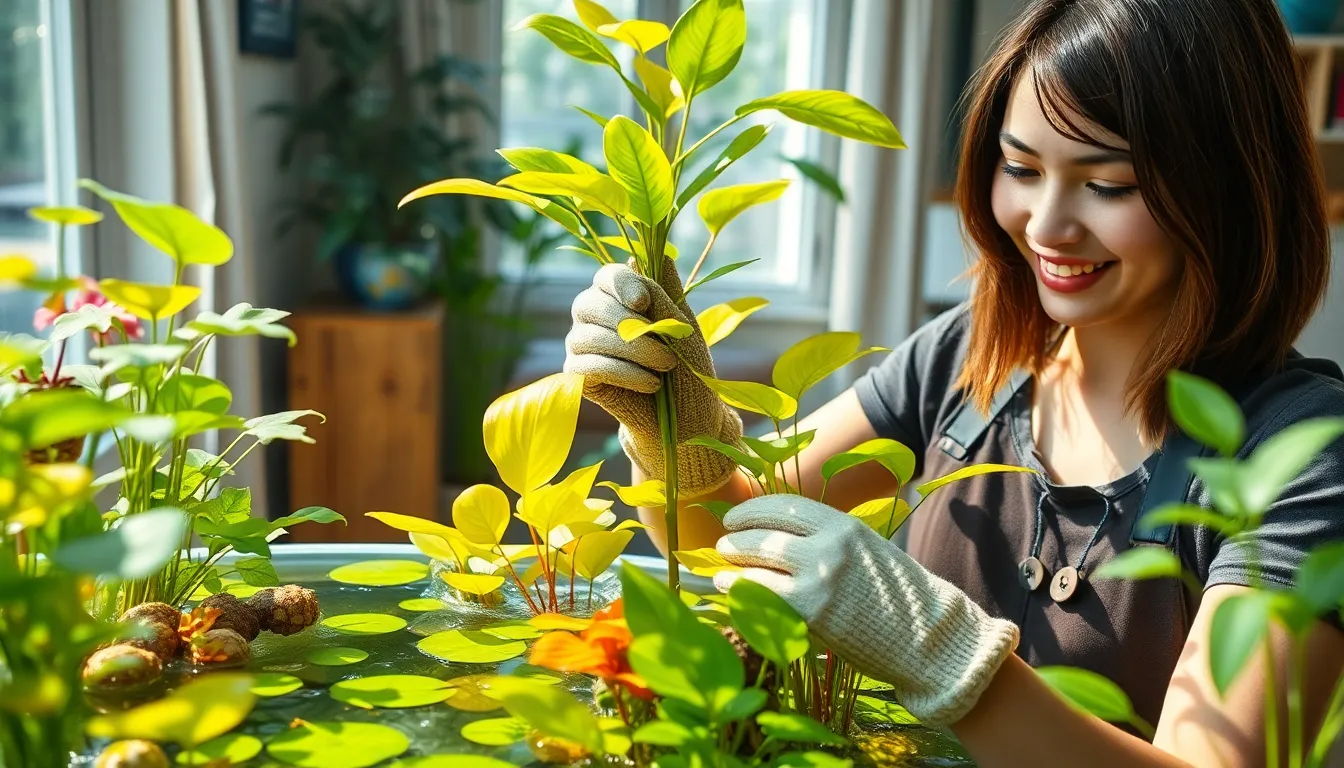
Establishing proper maintenance routines ensures our indoor water gardens thrive and remain beautiful focal points in our homes. Consistent care practices keep water quality optimal while promoting healthy plant growth throughout the seasons.
Weekly Water Changes and Cleaning Routines
Removing dead foliage weekly prevents decay that can contaminate the water and inhibit growth in our indoor gardens. We should carefully inspect each plant and trim away yellowing or brown leaves using clean scissors to maintain water quality.
Thinning overgrown floating plants allows sufficient light to reach submerged plants beneath the surface. We need to remove excess floaters regularly since they can quickly multiply and block essential light from reaching other plants in our water garden.
Water evaporates quickly indoors, so we must top off the water level regularly to maintain a stable environment for our aquatic plants. Checking water levels twice weekly helps us catch evaporation issues before they stress our plants.
Gently cleaning plant roots with an old cloth or toothbrush reduces soil buildup and prevents algae growth around the root systems. We should perform this cleaning during our weekly maintenance routine to keep the entire system healthy.
Nutrient Management and Fertilization Schedule
Regular fertilization proves crucial for thriving indoor water plants, so we use aquatic plant food in pellet form inserted into the substrate approximately every month. This controlled release method provides steady nutrition without overwhelming our plants with excess nutrients.
Balancing nutrients supports true aquatic plants (fully underwater), semi-aquatic plants (roots submerged with foliage above water), and floating plants since each type has different nutritional requirements. We adjust our fertilization approach based on the exact plant varieties in our collection.
Avoiding nutrient buildup prevents algae overgrowth that can cloud our water and compete with our desired plants. Proper cleaning routines combined with monthly fertilization help us maintain this delicate balance effectively.
Troubleshooting Common Growth Problems
Monitoring for excessive algae or root rot helps us catch overwatering issues early, though these problems are rare in properly maintained water gardens. We control algae through consistent cleaning routines and careful nutrient management to keep our water crystal clear.
Addressing inadequate lighting becomes necessary when overgrown floaters stunt plant growth by blocking light penetration to submerged plants. We thin floating plants regularly to ensure all levels of our water garden receive adequate illumination.
Controlling mosquito larvae requires using mosquito dunks containing Bacillus thuringiensis var. israelensis, which remains safe for both plants and humans while eliminating unwanted pests. We add these biological controls as needed during warmer months when mosquito activity increases.
Identifying yellowing or wilting leaves helps us diagnose nutrient deficiencies, water quality issues, or environmental stress in our plants. We adjust our care routine accordingly by modifying fertilization schedules, improving water quality, or relocating containers to better lighting conditions.
Design Creative Display Ideas for Your Water Plants
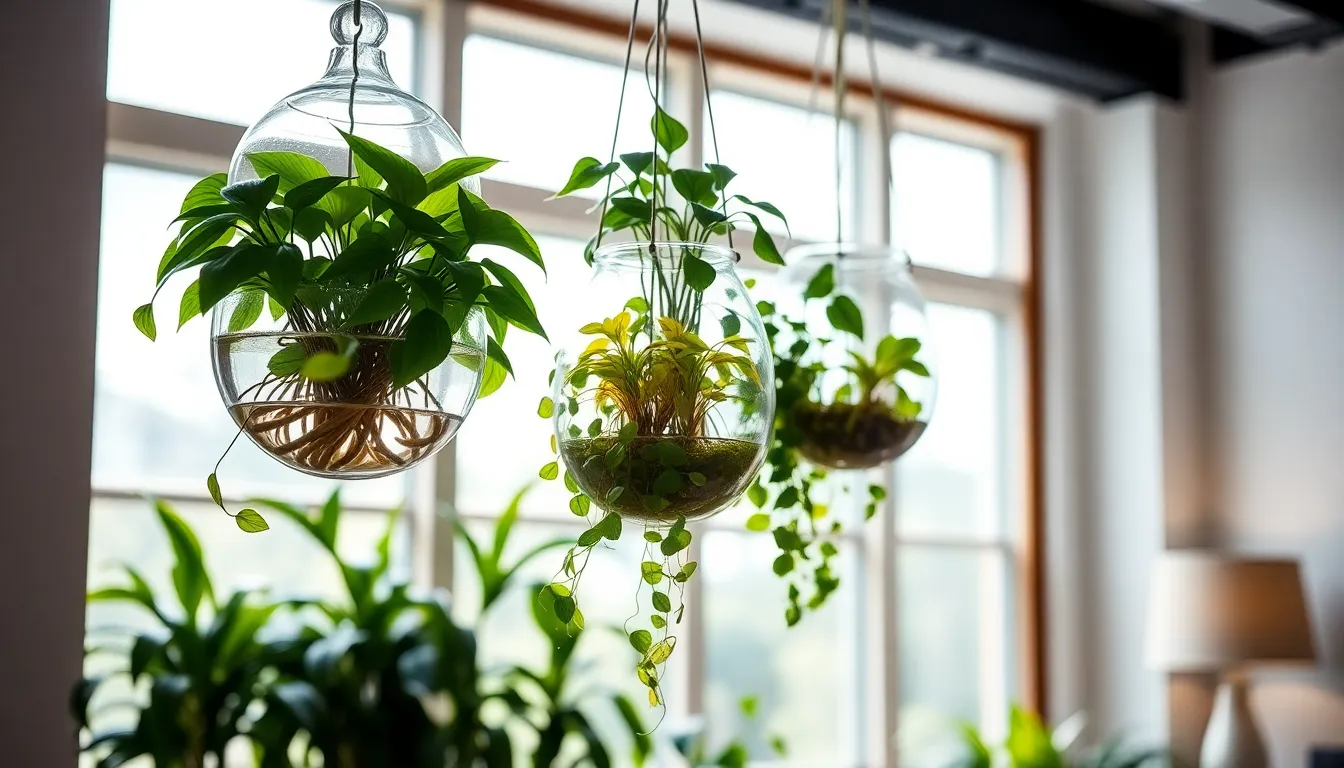
We’ll transform our indoor spaces with stunning water plant displays that maximize visual impact while working within any room’s constraints. Creative arrangements let us showcase our thriving water gardens as living art pieces that enhance our home’s aesthetic appeal.
Hanging Water Gardens for Vertical Spaces
Suspended glass containers create breathtaking vertical gardens that draw the eye upward while conserving precious floor space. We can use glass jars, elegant vases, or small decorative containers filled with water and suspend them using macrame hangers or stylish wire supports near windows or along empty wall sections.
Strategic plant selection matters when designing hanging displays since we need varieties that adapt well to suspended growing conditions. Plants like pothos and wandering jew thrive in hanging water arrangements because their trailing nature creates beautiful cascading effects that soften room corners and add natural movement to static spaces.
Weight distribution becomes crucial for safety when we’re mounting multiple hanging containers along the same wall or ceiling area. We should space our water gardens evenly and use appropriate hardware rated for the combined weight of containers, water, and fully grown plants to prevent accidents.
Terrarium-Style Arrangements with Multiple Plants
Multi-plant glass bowls allow us to create captivating aquatic ecosystems that serve as stunning tabletop centerpieces or shelf displays. We layer decorative stones, colorful sand, or smooth pebbles at the container’s base before adding water to establish an captivating foundation that supports multiple plant varieties simultaneously.
Aquatic plant combinations work best when we select species with similar water and light requirements to ensure balanced growth throughout our terrarium display. We position cuttings strategically so leaves remain above the waterline while roots develop below, creating natural layers that add depth and visual interest to our arrangement.
Container sizing affects how many plants we can successfully include in each terrarium style setup without overcrowding. Larger glass vessels like aquariums or oversized bowls accommodate more diverse plant selections, while smaller containers work perfectly for compact displays featuring 2-3 carefully chosen specimens that won’t outgrow their space quickly.
Seasonal Decorating with Water Plant Displays
Rotating decorative elements keeps our water plant arrangements fresh and exciting throughout the year by incorporating seasonal touches that reflect current holidays or weather changes. We add colored stones during autumn, festive ornaments in winter, bright pebbles for spring, and tropical accents during summer months to refresh our displays regularly.
Themed seasonal containers let us swap out our standard glass vessels for holiday exact options that complement our home’s seasonal decor schemes. We might use pumpkin shaped containers in fall, crystal clear vessels with winter themed accessories, or bright ceramic bowls that capture spring’s vibrant energy while maintaining proper growing conditions for our plants.
Coordinated plant selections enhance seasonal themes when we choose varieties that naturally complement different times of year through their foliage colors or growth patterns. Lucky bamboo works beautifully for minimalist winter displays, while peace lilies with their white blooms create perfect spring arrangements that bridge the gap between our water gardens and traditional seasonal decorating approaches.
Conclusion
We’ve explored every aspect of creating stunning indoor water gardens that transform our living spaces into peaceful retreats. From selecting the perfect low-maintenance plants to choosing containers that complement our home decor these DIY projects offer endless possibilities for creativity and customization.
The beauty of water plants lies in their simplicity and adaptability. Whether we’re propagating new plants from cuttings or maintaining established displays the techniques we’ve covered ensure long-term success with minimal effort.
By implementing proper water preparation lighting conditions and regular maintenance routines we’re setting ourselves up for thriving indoor gardens that purify our air while adding natural elegance to any room. Start small experiment with different arrangements and watch as these aquatic beauties become the focal points of our indoor spaces.
Frequently Asked Questions
What are the best beginner-friendly water plants for indoor gardens?
The best beginner water plants include pothos, lucky bamboo, spider plants, and philodendrons. These varieties are extremely low-maintenance, thrive in water environments, and require minimal care. They adapt well to indoor conditions and are perfect for those new to water gardening, offering beautiful foliage while being virtually impossible to kill.
What type of containers work best for indoor water plants?
Glass vases and jars are ideal for modern aesthetics, allowing you to showcase roots and monitor water levels easily. Repurposed household items like plastic bottles and old containers also work well as creative, eco-friendly planters. Choose containers based on your plant size, starting small and upgrading as plants mature.
How do I prepare water for my indoor water garden?
Use bottled water, rainwater, or tap water that has stood for 24 hours to allow chlorine to dissipate. Replace water regularly and monitor clarity to prevent bacterial buildup. Position containers in bright, indirect light and consider adding liquid organic houseplant fertilizer occasionally, but use sparingly to avoid over-fertilization.
How can I propagate my water plants to expand my collection?
You can propagate water plants through stem cuttings, root division, or seed starting. For stem cuttings, make clean cuts below nodes and place in fresh water. For established plants, separate clumping sections through root division. Some aquatic varieties can be started from seeds in water with proper moisture control.
What lighting and temperature conditions do indoor water plants need?
Position containers near bright windows for indirect sunlight and use supplemental grow lights during winter months. Maintain temperatures above 70°F (21°C) and slightly elevated humidity levels for tropical aquatic plants. Grouping plants together can enhance humidity and create beneficial microclimates for optimal growth.
How often should I maintain my indoor water garden?
Perform weekly maintenance by removing dead foliage, thinning overgrown floating plants, and topping off water levels. Add aquatic plant fertilizer monthly to support growth while avoiding nutrient buildup that causes algae. Monitor for common issues like yellowing leaves or excessive algae growth and address them promptly.
Can indoor water plants really purify the air in my home?
Yes, certain water plants like peace lilies, snake plants, Chinese evergreens, and rubber trees effectively filter indoor air pollutants while thriving in hydroponic systems. These plants remove common household toxins and improve air quality, making them both decorative and functional additions to your home environment.
What are some creative ways to display my water plants?
Create hanging water gardens using suspended glass containers to maximize vertical space, or design terrarium-style arrangements for captivating ecosystems. Consider seasonal decorating themes to keep displays fresh and strategically select plants based on their growth patterns and visual appeal for the most stunning arrangements.

